Millennials Are Buying Homes in These Top Cities
While millennials are waiting longer to buy a house than their parents did, the interest to become homeowners is still there. As millennials turn to the home buying process, some cities are proving more attractive than others. According to a recent National Association of Realtors report, millennials tend to choose cities that already have a high share of millennial residents, as well as favorable economic conditions.
With a combination of affordable homes, available jobs, good public transportation, and an active community, these are the top five U.S. cities where millennials are putting down roots by purchasing a home.
5. Salt Lake City, Utah
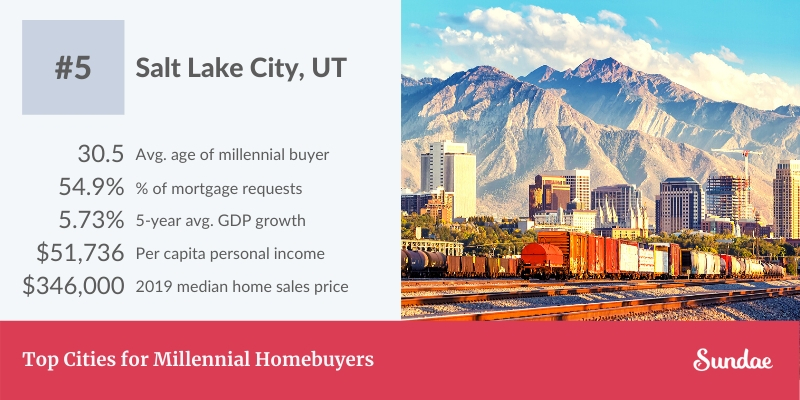
Salt Lake City seems to have the perfect combination of attractive qualities for millennials looking to settle down. As a growing tech hub set against the picturesque landscape of the Salt Lake and Wasatch Mountains, the city has affordable housing and a sub-four percent unemployment rate.
Drawing in a large percentage of millennial buyers, the downtown area is both walkable and transit-accessible and provides ample opportunities for experiences. An open-air mall, variety of restaurants, bars and pubs, and a thriving theater scene are among the central attractions here. Meanwhile, world class skiing, outdoor recreation, and wilderness adventure are just a short drive away from Salt Lake’s urban core.
The city also takes a proactive approach to being environmentally-friendly, which is a big plus for younger generations looking for a clean environment and alternative forms of transportation. Salt Lake offers access to bikes and scooters and is one of the more progressive bike lane cities in the country. To incentivize clean vehicles, the city continues to build free charging stations for electric cars. By 2032, Salt Lake City hopes to transition the entire community to 100 percent renewable electricity.
4. Denver, Colorado
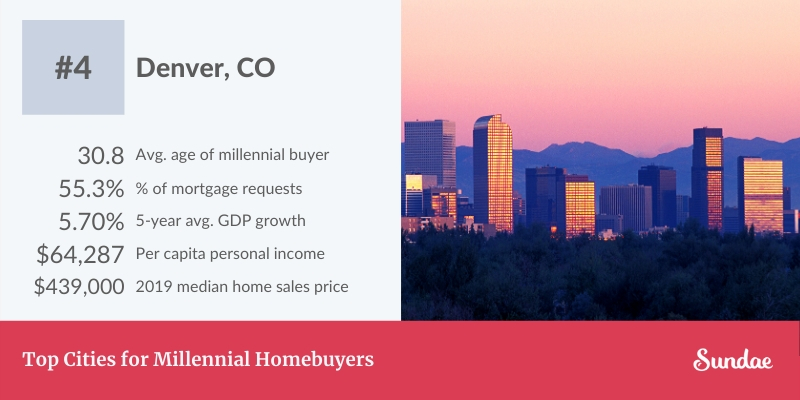
Denver is a moderately affordable city with a lot of potential. New industries are emerging and old ones are evolving, providing opportunities for entrepreneurs here that are hard to find elsewhere. Interest in Denver shows in the numbers, with more than 76,000 millennials coming and going in 2018. Additionally, unemployment dipped down in October 2019 to 2.6 percent, a historic low.
The Mile High City has a lot to offer active millennials with proximity to skiing, snowboarding, and a variety of other winter activities. Whole areas of town, like Union Station, LoDo, and RiNo have been renovated to cater to young residents with pubs, microbreweries, and hip restaurants. The city’s reputation as a progressive hub also makes it attractive for people of like mind.
Recently implemented mass transit lines make the city very accessible, which adds appeal for transit-loving millennials. Denver’s public transportation expansion program, called FasTracks, continues to grow, with a recent line connecting the airport to Union Station and another making it easier for people living in the northern suburbs to get downtown. The ability to avoid a car payment and get everywhere via public transportation is alluring to new homebuyers needing to save a few dollars where they can.
3. San Jose, California
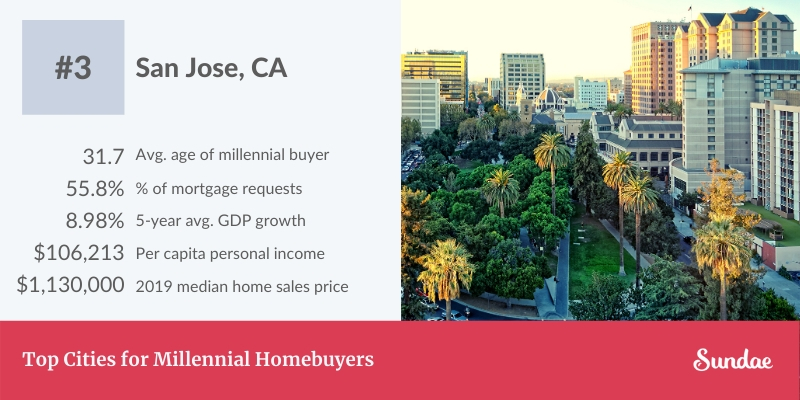
As the world’s most renowned technology hub with companies like Google and Apple in close proximity, it’s no wonder millennials are drawn to San Jose by the tens of thousands. Although palatial homes in the area drive up the median home price, plenty of options remain available that align with the lofty salaries of blossoming Silicon Valley tech professionals.
You also can’t beat the weather in San Jose, which is the definition of ideal. Average highs in the early months of the year are in the low sixties, and summer months don’t usually see temperatures above the mid-eighties. For outdoor-loving millennials, there’s almost never a time that will force you to stay inside.
As a melting pot of cultures, San Jose offers a vibrant restaurant scene and many multicultural events. There’s a growing presence of craft beer breweries for those who enjoy grabbing a pint they can’t find anywhere else. With a number of museums and cultural attractions, there’s always something to do in the rare moments residents of this busy city aren’t working. Surrounding destinations like San Francisco, Yosemite, Big Sur, and Napa Valley round out the incredible attractiveness of San Jose.
2. Buffalo, New York
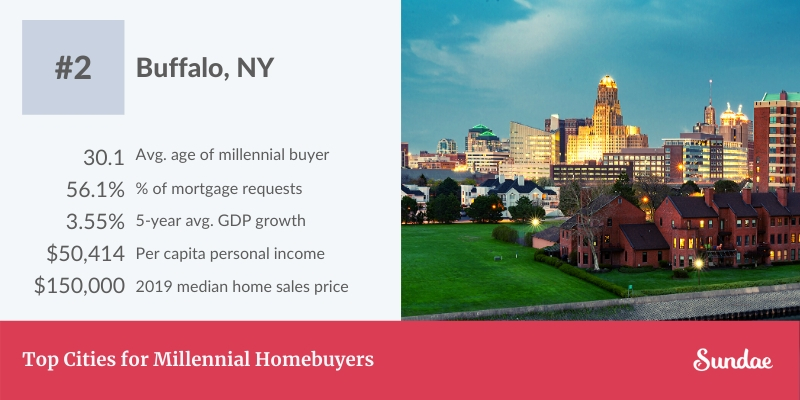
To millennials looking for an affordable, urban area to buy their next home, Buffalo is a popular destination. With low median home prices, millennials can afford more here than in most other major cities in the U.S. The result is all the benefits of a big city without having to pay full price.
Jobs in the private sector are on the rise in Buffalo, too, according to CBS News. Even though unemployment was higher than the national average at 4.4 percent as of November 2019, professional opportunities in financial services, education, and healthcare abound in Buffalo.
The city’s rich history as a manufacturing and transportation hub aside, Buffalo has undergone a recent transformation that entices millennials. A redeveloped waterfront in America’s Best Designed City includes three distinct locations, containing a combination of bars, restaurants, water activities, and green spaces. As the birthplace of buffalo wings, there’s no lack of great places to eat. When all else fails, and you’re looking for an experience to ‘wow,’ take the 20-mile trip out to Niagara Falls.
1. Minneapolis, Minnesota
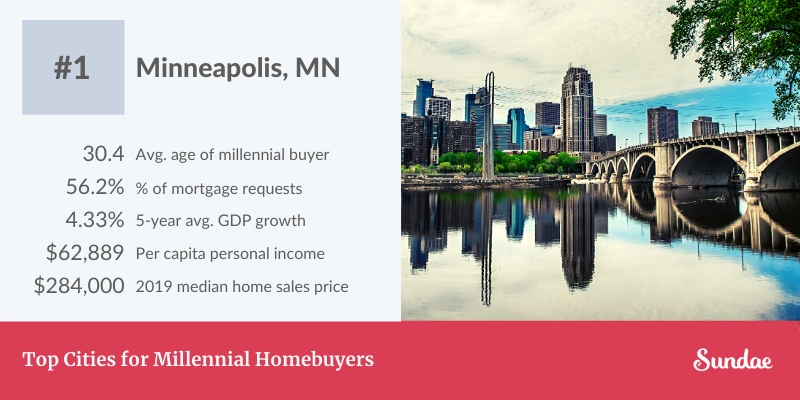
Though the cold winters may not be for everyone, Minneapolis tops the list of cities for millennial homebuyers due to its strong economy, affordable housing, and blend of urban characteristics loved by this generation. As a hub for entrepreneurs, the city attracts huge numbers of young professionals looking to build the next great startup. Career opportunities are also on the rise in the thriving biomedical, professional services, and technology sectors. With a low unemployment rate of three percent, chasing a job opportunity to the Land of 10,000 Lakes is a safe bet.
In 2018, almost 22,000 millennial-aged people made the move to Minneapolis, according to SmartAsset. The relatively low median price of homes and wide range of activities are a significant draw for millennials. The parks and lakes entice people outside and offer endless options for those who enjoy running, hiking, cycling, kayaking, fishing, and other outdoor sports. Museums, brew pubs, markets, and historical sites create a combination of activities that will keep anyone busy and appeal to all interests.
The compact downtown area offers a light rail and bus system to make getting around easy. You can also rent a bike on the street or bring your own to navigate the dedicated bike lanes all over the city. Being built around a park, Minneapolis is a great walking town.
Other peak destinations for millennial homebuyers
Outside the top five list, people entering their 30s are increasingly deciding to call these cities home:
- Pittsburgh, Pennsylvania
- Milwaukee, Wisconsin
- Austin, Texas
- St. Louis, Missouri
- Detroit, Michigan
- Boise, Idaho
- Omaha, Nebraska
- Oklahoma City, Oklahoma
Each location has its own unique draw, and all have between 53 and 55 percent of their mortgage requests coming from millennial homebuyers. As millennials represent about 30% of the American voting age population, this number reflects a city with a large number of millennial homeowners.
Methodology
Data for this assessment comes from the following sources:
- Millennials are defined as those born between 1981 and 1996.
- Age and mortgage data are from Lending Tree’s list of popular cities for millennial homebuyers.
- Median home sale prices are based on MSA data for all homes sold in the area, between January 1, 2019 and December 31, 2019, based on figures provided by First American Data. These numbers are subject to frequent change (based on fluctuations in the residential housing market).
- Personal income data are derived from public statistics made available by the Bureau of Economic Analysis. City figures are based on MSA.
- GDP growth numbers were provided by an analysis of MSA data from the Federal Reserve Bank of St. Louis.
When you’re ready to move
If you’re considering moving to one of these cities and need to sell your current home, Sundae can help. Sundae is the only marketplace that connects homeowners looking to sell their homes as-is to the largest network of investors to ensure the highest possible offer. By getting your property in front of hundreds of local investors, we help you get the highest possible price. Our painless process gets you the highest off-market price for your house without having to do anything to prepare it.
Ready to Get Started?
Sell as-is. Pay zero fees to Sundae. Move on your time. No repairs, cleanings, or showings.
